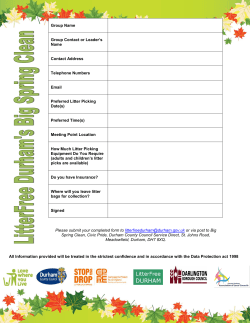
(Micro-)Plastics in the Environment The German Perspective
Für Mensch & Umwelt (Micro-)Plastics in the Environment The German Perspective Dr. Lilian Busse Head of Division Environmental Health and Protection of Ecosystems Marine Litter in the North Sea & Baltic Sea: Observations and estimates Southern North Sea: In average 236 litter items per 100 m coastline (average entire North Sea 712 items/100m) (ongoing OSPAR beach litter monitoring) 11 kg litter per km² seafloor (UBA R&D 2013) 96 % of dead found Northern fulmars contain plastics in their stomachs (average 25 items (0.43 g)) (UBA R&D 2014) 97,4 % of nests assessed of the Gannet colony at Helgoland contain plastics (net rests, ropes) (UBA R&D 2014) Baltic Sea: Litter on beaches range from 76 items/100m at rural to 237 items/100m at urban beaches (project MARLIN 2013, HELCOM 2014) 5,500 – 10,000 lost fishing nets annually (HELCOM 2014) Micro-particles in the water column (size range 10-220 µm): up to 4 fibres and 32 other anthropogenic litter particles/ L-1 (Magnusson & Noren 2011) 11.05.2015 @J. van Franeker (IMARES), www.forthseabirdgroup.org (Micro-)Plastics in the Environment (Micro-)Plastics in the Environment - The German Perspective; Dr. Lilian Busse; UBA DE 2 Annual Plastics Demand of Selected Industries in Germany* Mio. Tons/Year 12 Annual Plastics Demand (2013) 9,7 10 8 6 Annual Plastic Waste (2013) 5,6 4 3,1 2,1 2 1,4 0,8 0,8 0,4 0,5 0,4 0,2 0 * According to PlasticsEurope 2013 11.05.2015 (Micro-)Plastics in the Environment - The German Perspective; Dr. Lilian Busse; UBA DE 3 Annual Plastics Production in Germany* Mio. Tons/Year Annual Plastics Production (2013) 3 2,7 2,5 1,9 2 1,8 1,5 1,5 1,2 1 0,5 0,3 0,6 0,5 0 PE PP PS PS-E PVC PA Other TP Other * According to PlasticsEurope 2013 11.05.2015 (Micro-)Plastics in the Environment - The German Perspective; Dr. Lilian Busse; UBA DE 4 Selected Pathways of Plastics - From Sources to Sinks Littering Households Sources Industry Stormwater, Untreated Waste/Wastewater Technical Facilities Treatment (WWTP, Waste Incineration, Disposal Sites) Different Transport Mechanisms Water Regulated Entry and Quantity Soil Air Transport Accumulation in the Environment Water 11.05.2015 Unregulated Entry and Quantity Soil Air (Micro-)Plastics in the Environment - The German Perspective; Dr. Lilian Busse; UBA DE Sinks 5 Plastics and Microplastics (Primary and Secondary) in Germany - Available Data 111.000 * Tire Abrasion Treated/Untreated Entries and Quantities? 50.000** Littering Cosmetics 545 *** Biowaste 15.000 *** 5.000 Sewage Sludge Residue in the River Rhine ** 25 Residue in the Treated Effluent ** 8 0 20.000 40.000 * According to Hillenbrad et al. (2005) ** According to a UBA estimation 11.05.2015 60.000 80.000 100.000 Tons/Year 120.000 *** Limit Value for impurities in Fertilizer Ordinance (max. 0,5% of DM) (Micro-)Plastics in the Environment - The German Perspective; Dr. Lilian Busse; UBA DE 6 Treatment of Waste Water in Germany Foto: Andreas Hartmann 11.05.2015 Micro-)Plastics in the Environment - The German Perspective; Dr. Lilian Busse; UBA DE 7 Untreated Water and Littering * *Bruno Tassin 11.05.2015 (Micro-)Plastics in the Environment - The German Perspective; Dr. Lilian Busse; UBA DE 8 Untreated Water and Littering * After a rain event in Berlin *Foto: Daniel Venghaus 11.05.2015 (Micro-)Plastics in the Environment - The German Perspective; Dr. Lilian Busse; UBA DE 9 Strategies and Measures to Reduce Marine Litter Coordinated from a Global to a National Perspective Honululu Strategy – A Global Framework for Prevention and Management of Marine Debris Rio + 20 agreement (art 163) – Significant reduction of marine litter until 2025 International Conference on Prevention and Management of Marine Litter in European Seas 2013 in Berlin - Identification of dedicated regional actions (Regional Action Plans in the EU) G7 – Action Plan on Marine Litter is one topic under discussion during current DE presidency Regional Action Plans on Marine Litter Barcelona Convention (Mediterranean) - Action plan on marine litter adopted in 2013 OSPAR (North East Atlantic) - Action Plan adopted in June 2014 HELCOM (Baltic) - Final adoption (Recommendation incl. actions) envisioned for June 2015 Bucharest Convention (Black Sea) - Marine litter part of an overarching strategic action plan EU MSFD PoM - measures aiming at reduction of marine litter closely linked with global and regional action NOTE - All action plans follow the same general structure 11.05.2015 (Micro-)Plastics in the Environment - The German Perspective; Dr. Lilian Busse; UBA DE 10 Planned Measures in Germany - Implementation of the Marine Strategy Framework Directive Environmental target 5: Seas without pressures from litter 11.05.2015 UZ5-01 Including the topic “marine litter” in learning goals, teaching plans and materials UZ5-02 Modification/substitution of products in a comprehensive life-cycle approach UZ5-03 Avoiding the use of primary microplastic particles UZ5-04 Reducing inputs of plastic litter e.g. plastic packaging, into the marine environment UZ5-05 Measures relating to lost and abandoned fishing nets and gear UZ5-06 Establishing the fishing for litter approach UZ5-07 Removing existing marine litter UZ5-08 Reducing amounts of plastic litter through local regulatory provisions UZ5-09 Reducing emissions and inputs of microplastic particles (Micro-)Plastics in the Environment - The German Perspective; Dr. Lilian Busse; UBA DE 11 Upcoming Challenges 1. − − − − Identification Specify objects to be identified Assess current situation (therefore: define harmonized, reproducible and representative methods) Analyze additional effects like persistency or microplastics as a vector Determine sources of possible pathways 2. − − − Evaluation Evaluate legal situation (water, soil, air, prevention of potential hazards) Evaluate properties of materials (physical, biological, chemical) Evaluate possible effects on health and environment 3. Measures Possible measures to reduce the pollution due to plastics are: Legal frameworks Economical incentives or penalties Education, communication and information − − − 11.05.2015 (Micro-)Plastics in the Environment - The German Perspective; Dr. Lilian Busse; UBA DE 12 Current and Planned Research in Germany (Examples) Federal Research BMUB − Coherent monitoring of German coastal and marine waters − Analysis of microplastics in water − Analysis of microplastics in food BMBF − JPI Oceans German Länder − Bavaria: Pathways, occurence and distribution of microplastics in Bavarian waterbodies − North Rhine-Westphalia: Occurence and distribution of microplastics in the River Rhine − Baden-Württemberg: Microplastic pollution of waterbodies in Baden-Württemberg Leibniz-Gemeinschaft − Microplastic as a vector for microbial populations in the ecosystem 11.05.2015 (Micro-)Plastics in the Environment - The German Perspective; Dr. Lilian Busse; UBA DE 13 Research Needs for Plastics and Microplastics Development of Methods: − Media specific consistent sampling techniques − Consistent sample preparation methods − Consistent and sensitive detection methods − Appropriate ecotoxicological methods − Mass flow analysis (soil, water, air) Monitoring/Surveys: − Survey of consistent data for different environmental media Processes: − Development of environmental sound polymers − Development of specific treatment processes (waste water) Behavior: − Study of the social behavior in relation to littering 11.05.2015 (Micro-)Plastics in the Environment - The German Perspective; Dr. Lilian Busse; UBA DE 14 Next Steps in Germany 1. Adopt and implement the MSFD measures on ML - 2016 2. Conduct projects that reduce (micro)plastic entries (“green associations”) 3. Coordinate various research activities (Federal/Länder) 4. Develop harmonized, reproducible and representative methods 5. Initiate standardization works in ISO TC 61 – Plastics 6. Gather further data on plastic distribution in the environment 7. Analyze (micro)plastic entries from different products 11.05.2015 (Micro-)Plastics in the Environment - The German Perspective; Dr. Lilian Busse; UBA DE 15 Conclusions 1. The ongoing discussions about plastics and microplastics in the environment prove that this topic needs further research and assessment 2. Measures to reduce inputs of litter to the environment with special focus on the seas have to be taken immediately 3. Effects and measures concerning other media like freshwater, soil and food should be taken into consideration 4. Harmonized, reproducible and representative methods need to be developed for the further assessment 5. Development of standardized methods (ISO) 6. A framework to assess the current situation needs to be set up 7. Further research needs to focus on areas with high uncertainty (e.g. DG RES (Horizon 2020), member states (JPI)) 11.05.2015 (Micro-)Plastics in the Environment - The German Perspective; Dr. Lilian Busse; UBA DE 16 Kontakt: Dr. Lilian Busse Head of Division Environmental Health and Protection of Ecosystems Environment Agency Germany Dessau 16.05.2015 / Hier steht der Veranstaltungstitel in 12 Punkt 17
© Copyright 2025









